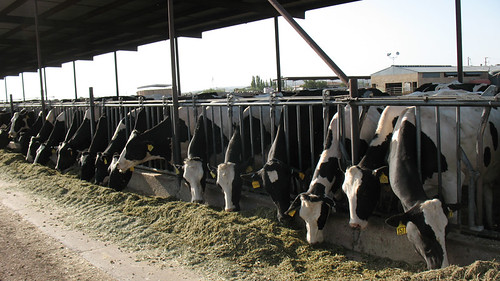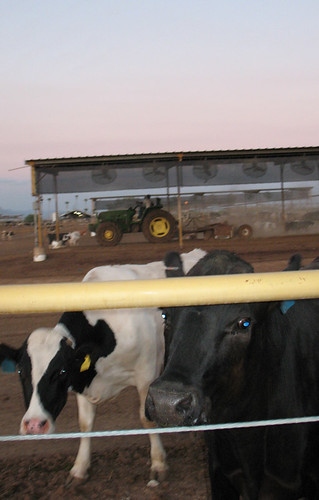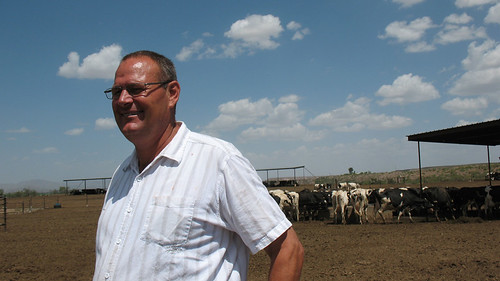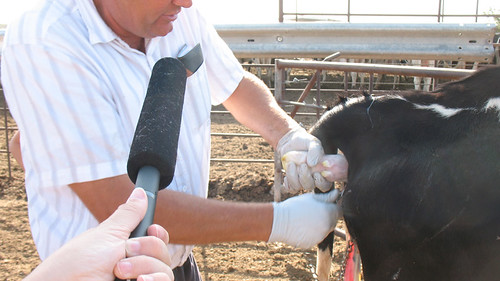Phoenix-based FI2W reporter Valeria Fernández produced a radio piece for NPR’s Latino USA on immigrants who work in the dairy industry and the farmers who hire them.
Here, Valeria narrates how she produced the piece, which airs this weekend on Latino USA. To listen to the piece, press “play” below.
[audio:http://latinousa.kut.org/wp-content/lusaaudio/859segAZdairies.mp3]
By Valeria Fernández, FI2W contributor
For almost two years now, one of my sources here in Arizona had insisted that I do a story about immigrants working in dairies. I finally started to work on this one about five months ago, before I even knew which direction it was going to take, or even that it was going to become a radio piece. I needed to become familiar with the universe of dairies at a time when Arizona was facing an intense crackdown on illegal immigration.
There was naturally going to be fear and resistance on the part of immigrant workers. For about two years now, the state has had a law in place that sanctions companies who knowingly hire undocumented labor.

Farmer Gerald Lunt says than “other than the economy and the price of milk,” finding workers is his biggest problem. (Photos: V. Fernández – Click to see more)
ALSO: Read a diary by the daughter of a Mexican immigrant dairy worker.
The law has been used mostly to conduct work-site raids in businesses, resulting in the arrest of a couple of hundred workers. The number is not large, but the chilling effect on local immigrant communities is much bigger.
In a couple of ways, this was unexplored territory for me. I was as nervous as the subjects of the story. Not only was I going to leave the comfort of print, but also, I was going to do it in English, my second language. I feared leaving my small notepad and using a microphone instead. Often times I would just tuck it away, and listen to people to help them relax.
There have been stories about workers in agriculture, but I wanted to do a story about what life was like in the dairies. I had all sorts of preconceptions.
Coming from Uruguay, where there’s about one cow per person, I was shocked to see that cows don’t run free eating green pastures. Instead, they’re locked in gigantic outdoor dirt corrals, air conditioned with fans.
 I was also surprised that in the milking parlors the cows weren’t milked by people, but by electrical pumps.
I was also surprised that in the milking parlors the cows weren’t milked by people, but by electrical pumps.
And one more thing: most of the milk we drink in Arizona comes from one of these dairies. They’re all interconnected through a cooperative in Tempe. The milk they produce gets mixed together.
It was tough to know where to start. So one Sunday morning, Gregorio León, a community activist, journalist Terry Greene Sterling –who is writing a book about immigration issues– and I started to visit dairies and the communities around them.
It didn’t look promising when we didn’t have an insider who could help us establish a bond of trust with the workers.
After waking a few people up asking for garage sales in the area, and making a morning biker suspicious, we came knocking at the door of Maria and Carlos.
Their son, Pedro, who was arranging gigantic piles of alfalfa hay on a tractor that Sunday morning, had pointed us in that direction.
Our conversation starter was: “Where can we buy cheese around here?”
They live in a small trailer on the premises of the dairy where Carlos has been working for 13 years. Maria’s mother happened to be in town visiting from Mexico and she promised to make some cheese for us. Which was delicious, by the way.
Maria and Carlos came from a small town in Zacatecas, Mexico. Carlos was a shepherd: that’s where he gets his wisdom with animals. On the farm, he saw himself as a cow doctor, being able to tell a cow was sick just because she looked sad.
He decided to take the trip to the U.S. after a long drought that killed most of his animals. Maria recalled the dangerous trek coming across the border with her two little children to meet him.
I’d expected Carlos to say he wanted to stay here, but he shared with us his dream of going back to Mexico. I was surprised too that he praised his boss regardless of how hard he had to work.
By the time the wheels of the story had been set into motion, something unexpected happened. Carlos told me his dairy was about to close –he was about to lose his job. And they were considering returning to Mexico, afraid of the new laws in Arizona that had made it more difficult to get a job without documents.
Headlines in California reported on plummeting milk prices. That’s when I realized our story was bigger than I originally thought. The economy and immigration enforcement were hitting both workers and employers with a double whammy.
When my producer suggested we find another family that could help tell the other side of the story, I was worried. I needed to find someone who had a different point of view towards immigration issues.
And then I met Gerald Lunt. He was just as open to talk as Carlos and Maria were. It was a refreshing surprise.
After four hours of driving with mountain ranges as a backdrop, we arrived at Lunt’s dairy. It really looks like it’s about to fall from the Arizona map into New Mexico. Lunt came in a small four-wheel vehicle, already busy with the tasks of the day.
It surprised me that Lunt –being a partial owner of his farm– worked as much as Carlos. Lunt wanted this lifestyle. He wanted his kids to grow up in a place where they learned about life and death.
My mentor, radio producer Rene Gutel and I, got a quick lesson when we were able to see a calf being delivered with Lunt’s help.
I quickly realized the dairies and these families had some down-to-earth wisdom to share about immigration.
This is a thorny subject in Arizona and across the nation. People don’t want to talk about it, most of the time they prefer to yell at each other. And often as reporters we present some of the black and white on each side, not the shades in between. In a way, we kid ourselves with the idea that we’re being fair and balanced, because we quoted this or that organization that claims to represent a certain constituency.
The voices of ordinary people get lost in the noise. But it’s when we take the time to listen to these voices that we realize that most people have hopes that unite them, the very basics of wanting the best for their families.
Being bilingual and bicultural helped me navigate through both worlds as a reporter. Doing this radio piece literally helped me listen closely. Yes, I was desperately hoping that cows would moo on the record, and people would talk in complete sentences. But I also discovered the shades of colors in people’s voices and their common ground: family.




